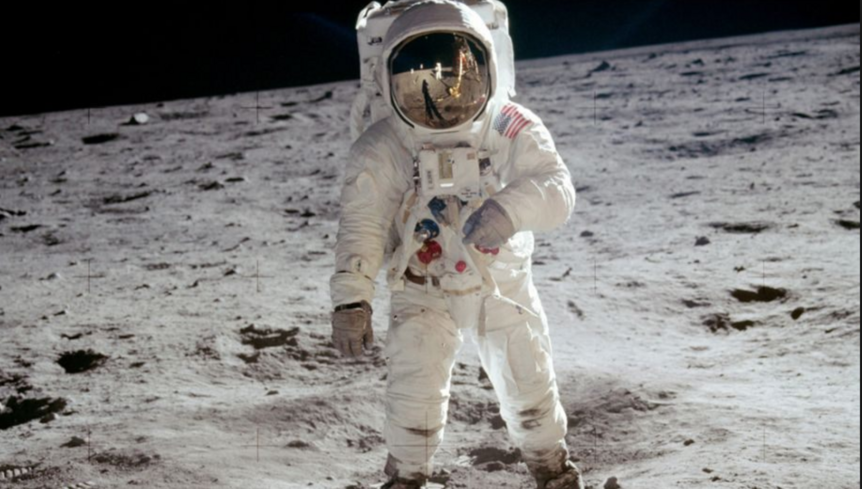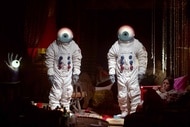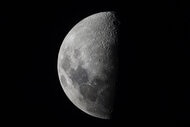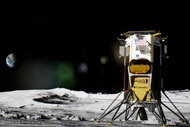Create a free profile to get unlimited access to exclusive videos, sweepstakes, and more!
If Apollo Astronauts Had Brought Back a Moon Plague We Couldn’t Have Stopped It
That's not the sort of alien invasion we envisioned.
On the afternoon of December 21, 1968, three astronauts — Frank Borman, Bill Anders, and Jim Lovell — strapped themselves to a Saturn V rocket and blasted into space. The mission was Apollo 8, the first crewed mission to leave low-Earth orbit and travel to the Moon. The story of that pathfinding mission plays out in First to the Moon, streaming now on Peacock. A few missions later, they were followed into the expanse by the crew of Apollo 11 who, save for Michael Collins, would become the first human beings to set foot on another world.
Upon their return, there was some concern from world authorities that lunar astronauts, equipment, and samples might be contaminated by otherworldly pathogen: Moon microbes. The notion of alien pathogens might feel a little silly today, but the Moon being sterile was not (and maybe still isn’t) a foregone conclusion. So, NASA set up a complicated and lengthy quarantine process to separate astronauts, equipment, and lunar samples from the rest of the world until we knew they were safe. It turns out, those efforts were grossly inadequate and the only thing which protected us from an alien plague was luck, according to a study published in the science history journal Isis.
RELATED: Apollo rocks reveal the Moon's past was a magnetic game of 'the floor is lava'
The post-Apollo 11 quarantine efforts appeared to be a resounding success. The crew of Apollo 11 spent a few weeks hanging out in quarantine and were released with a clean bill of health. In the meantime, nobody came down with a case of Moonpox and it eventually became clear that any risk of alien contamination had passed.
NASA’s $100 Million Lunar Containment Facility
Dagomar Degroot, an environmental historian from Georgetown University and the sole author of the new study, combed through historical records to get a sense of NASA’s Apollo-era quarantine efforts and whether they were effective. Largely, they were not. “The quarantine protocol looked like a success only because it was not needed. Luckily, there were no microorganisms discovered during the Apollo missions that were indigenous to the Moon,” Degroot said in the study.
NASA, in collaboration with other federal networks, spent roughly $100 million to develop and build the Lunar Receiving Laboratory (LRL), for the express purpose of quarantining lunar materials. The LRL was built in only 11 months, and with 16 months left on the clock before Apollo 11. In that time, NASA needed to staff, equip, test, and certify the facility. Key among those certifications was the assurance that the LRL was capable of containing a lunar pathogen, should one be found. That meant testing the facility against the nastiest bugs at our disposal.
They decided on Yersinia pestis, the bacterium responsible for the Black Death, as their test pathogen. It’s got plenty of cultural cache, it’s hard not to be feared when you’re called the Black Death, but Y. pestis isn’t actually a good test case for this purpose. It’s deadly, but it requires a very specific set of circumstances involving several animals in order to infect a person. That’s not the sort of thing we would expect to find on the Moon. Even in ordinary circumstances, Y. pestis only requires a facility with a biosafety level of two, out of a possible four. Given the potentially world changing consequences of alien contamination, the LRL was intended to be a biosafety level four facility. The choice of test pathogen was only the beginning of the problems, according to Degroot.
In early 1968, a chemist named John Hodge suggested using a different pathogen: Coxiella burnetii. It’s capable of forming spores which could protect it from the harsh conditions of the Moon, and it spreads easily through aerosol infection. Those are the sorts of qualities planetary defense folks worry about, but C. burnetti is also highly infectious and posed a risk to key NASA employees. That’s something NASA couldn’t accept, so close to the launch of Apollo 11. In the end, the decision was made that all prep should involve harmless analogues, even if that meant a less effective test.
RELATED: Is the 50-year-old ghost of Apollo 13 warning us not to rush to the Moon?
Degroot says this is just one example of NASA prioritizing speed or geopolitical competition over public safety: prioritizing higher probability problems to astronauts or equipment over lower probability risks to the world, even if they are potentially catastrophic. In the case of the Apollo program, the gamble paid off, but it might have gone another way.
After Apollo 11 returned, a total of 24 NASA workers were exposed to lunar materials and had to be quarantined themselves. That shouldn’t have been possible if the LRL worked as intended. Certainly, it shouldn’t have been possible 24 times. Moreover, any attempt at containment was likely lost the moment astronauts returned. Their spacecraft vented into the atmosphere during descent and the hatch opened up onto the ocean. If there had been any microbes capable of surviving in Earth’s oceans, the battle would have been lost before it started.
Half a century on, with the Artemis program in full swing and a Martian sample return mission in progress, space agencies and world leaders have an opportunity, and an obligation, to revisit their plans and procedures for protecting the world from a microscopic alien invasion.
While you’re waiting for Artemis II, brush up on your Apollo history with First to the Moon, streaming now on Peacock!



















